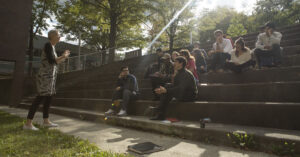
For college students, textbooks have always accounted for a portion of the average students’ debt. Students spend an average of $150 per course and an estimate of over $1000 a year on books and materials. With this in mind, seeing how many students are burdened by this is no surprise. To combat this ongoing issue, SUNY stands committed to expanding Open Educational Rersources and making them available to more students for more uses. Chancellor Kristina M. Johnson recently announced that the amount of general education courses provided at SUNY will double. This announcement is part of an effort to continue aid in providing SUNY students more and more help for textbook savings. “With SUNY Achieve, we do everything possible to alleviate students’ financial struggles,” said Chancellor Johnson at the 2020 State of the University System Address. “OER is now offered on 59 of our campuses, and over the past 3 years, it has saved SUNY students $47 million dollars in textbook costs.”
What are Open Educational Resources?
Open Educational Resources (OER), an open access textbook initiative, provides easily attainable, manageable, and cost-effective general education courses for undergraduate SUNY students. OER provides students with free access to their course materials, without restrictions. With different licensing attributes than traditional course materials, OER provides instructors with flexibility in how they facilitate their lessons. “Typically, an OER utilizes a Creative Commons license, a type of copyright license that permits the use of the OER in perpetuity and allows for the OER to be used for any educational purpose, including its use, reuse, and revision, thus allowing our faculty to personalize the learning experience for students.” said SUNY Library Senior Strategist, Mark McBride.
The courses will vary in numerous general education, as well as major-specific courses in subjects like Business, English & Communication, Humanities & Languages, Mathematics, and many others. Some of the courses include microeconomics, elementary Chinese, American literature, biochemistry and STEM Readiness. OER courses will motivate students to apply their knowledge, and increase their understanding of lessons, resulting in the improvement of students’ performance. And of course, OER courses can be found at both 2 and 4-year schools across the SUNY system.
How Does it Work?
With OER, students are able to practice more active learning techniques, encouraging participation instead of solely passive learning. The OER courses provided will have the option to be both facilitated online, as well as in in-class lectures. This also benefits professors as they are able to tailor course lessons to be as beneficial and creative as possible, by modifying the material to include information that is necessary and relevant to the students’ learning experience. OER courses will be comprised of newly developed quality texts, lesson plans, syllabi, lab manuals, lecture notes, and homework systems, including graphics to increase students’ engagement.
As of today, SUNY students have enrolled in 14,581 OER courses since its start in 2017. With the number of students who have already enrolled, open educational resources are sure to further increase change for the better in collaboration between students and professors at SUNY.
For more information about Open Educational Resources (OER), visit oer.suny.edu



